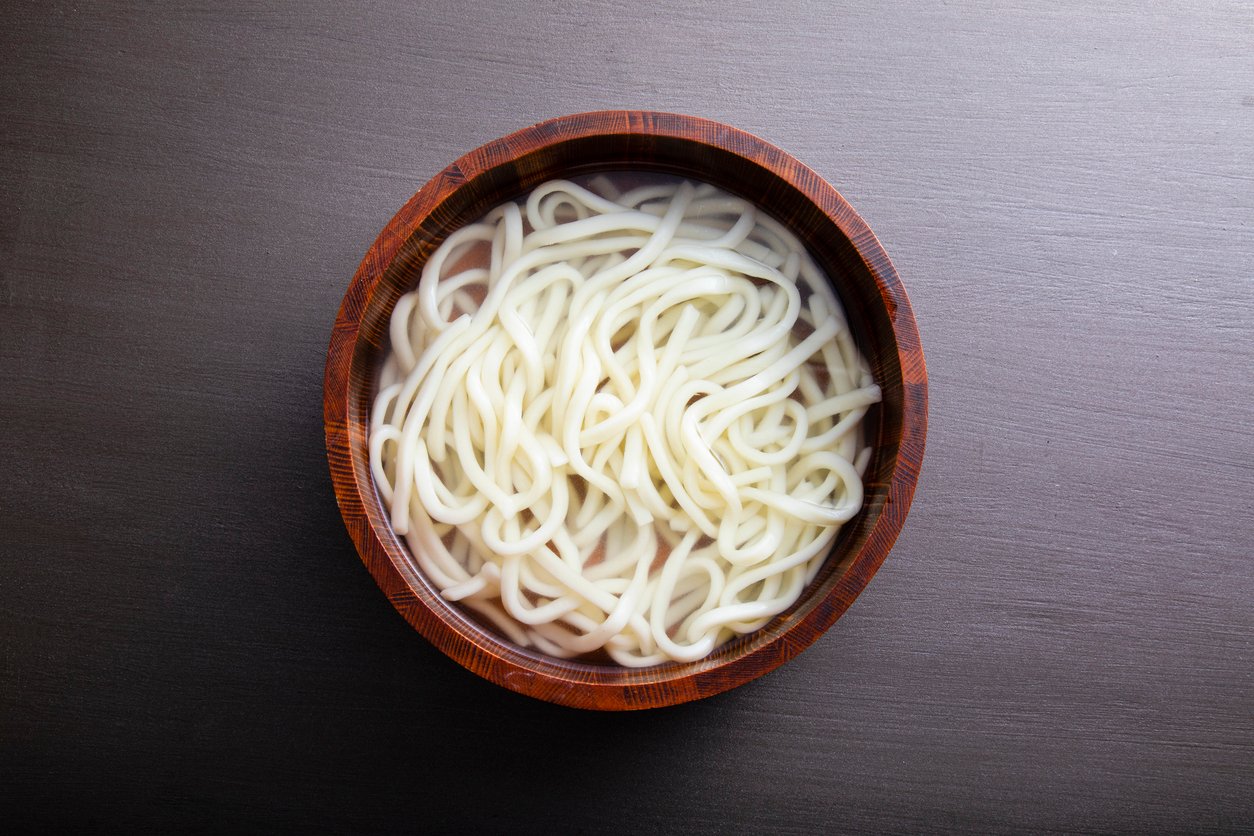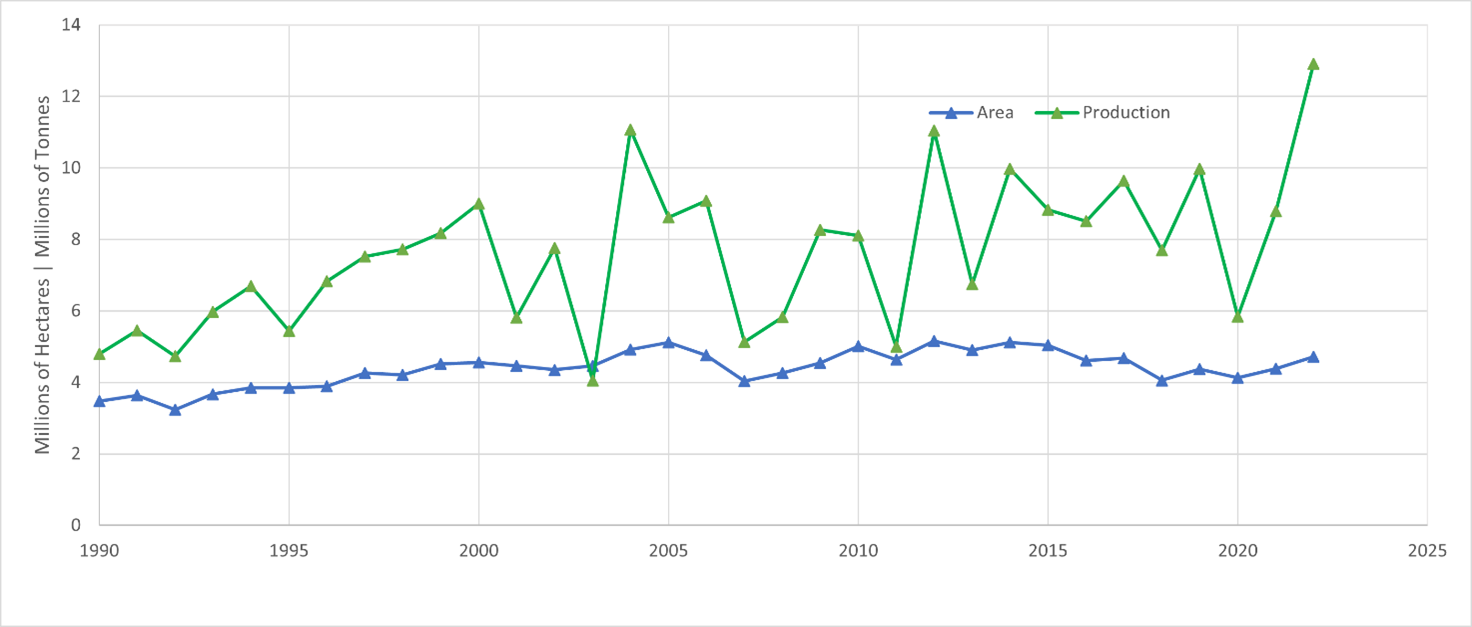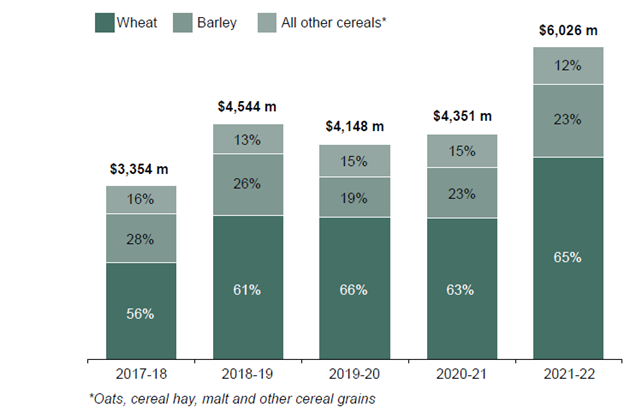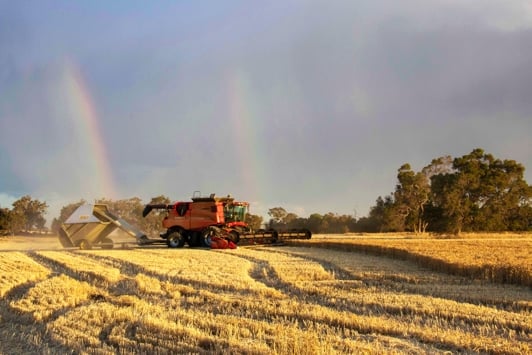Approximately 10 million tonnes generated annually in a rain-fed system across 4 million hectares of land. About 95% of wheat grown in Western Australia is exported - predominantly to Asia and the Middle East - generating $2 to $5 billion in annual export earnings for the state.
Western Australian wheat industry
WA generates approximately 40% of Australia's total wheat production with more than 95% of this exported, predominantly to Asia and the Middle East. WA produces white grained wheat varieties that generate high flour milling yield and a bright white flour that is suitable for a range of products. Wheat production occurs across the WA wheatbelt on 4000 mostly family-run farms, ranging in size from 1000 to 15,000 hectares.
The department has a strong research, development, and extension focus on wheat production, with investments across the wheat value chain from pre-breeding and agronomic research to support variety development to pest and disease management. Grain quality assessment and export market intelligence research is undertaken by the Australia Export Grains Innovation Centre (AEGIC).

Wheat in udon noodles
WA is the world’s major supplier of wheat for Japanese white salted udon noodles – a one million tonne market supported by a long collaboration between the department, AEGIC, the Grains Industry Association of Western Australia (GIWA), and Japanese flour millers.
The department has hosted visiting Japanese noodle manufacturers and flour millers since 1990 - a program that has enabled WA to be in tune with Japanese quality expectations of WA noodle wheat varieties.
Production
The area sown to wheat in WA over the past 30 years has remained relatively stable at between 4 to 5 million hectares but over this same period production has increased strongly with improved yields. As a result, we are seeing production of 8 to 10 million tonnes per annum.
Improved agronomic practices and development of new premium wheat varieties have enabled an increase in WA wheat yield over the past 30 years, at a rate higher than world average, despite a decline in annual rainfall.

Western Australian wheat area and production 1989-90 to 2021-22
Grown under rain-fed conditions, WA wheat production can fluctuate from season to season. Seasonal variability, particularly since the year 2000, combined with increased competition from countries with lower costs of production, have placed pressure on wheat profitability. Despite this, a recent study of WA wheat producers found the financial position of almost two thirds of WA farms can be classed as 'growing' or 'strong' due to their use of technology to create economies of scale and their managerial and social characteristics.
The department has a strong research, development and extension focus on wheat production through its long history in wheat breeding - now privatised through InterGrain - and the development of wheat variety management information for the state’s grain production zones.
Markets
Wheat has much less market concentration than other grains. China and Indonesia are WA's largest wheat export markets. These markets have recently come under pressure from increased competition from low-cost producers. To counter this, the department (through AEGIC) is actively engaged with Indonesian milling companies to gain a better understanding of their grain quality requirements and the performance of WA wheat varieties in the milling and baking process.

Cereal value of exports 2017-18 to 2021-22. Source: ABS export data
Wheat quality
WA produces white grained wheat varieties that generate a bright white flour and high flour milling yield.
WA wheat typically has low moisture content, low discolouration, and high bulk density, and is suitable for a range of products, including different breads.
WA's dry harvesting environment results in low moisture content and low risk of weather damaged grain.
Major wheat milling grades in Western Australia are:
- Australian Hard (AH): used for breads; about 12% protein.
- Australian Premium White (APW): used in blends for breads, including European and flat breads, some noodles and steamed breads; about 10.5% protein.
- Australian Standard White (ASW): used for flat breads, steamed (Asian) breads, noodles; 9 to 10.5% protein.
- Australian Standard Noodle Wheat (ANW): specifically for Japanese udon noodles; 9.5 to 11.5% protein.
- Australian Premium White Noodle (APWN): WA only. Used for blending; 10.0 to 11.5% protein.
- Australian Soft (ASFT): used for biscuits, cakes, steamed buns; less than 9.5 % protein.
Diseases and pests of wheat
When selecting a wheat variety, it is important to consider its yield and potential quality grade, and its disease resistance.
The severity of disease in wheat crops depends on the presence of inoculum carried over from last season, favourability of seasonal conditions, pathotype virulence, and varietal susceptibility.
An annual review of your crop’s disease resistance ratings is vital, as disease risk profiles change with the introduction of new pathotypes. Refer to the Western Australian crop sowing guide below for disease resistance ratings for wheat varieties.
A rapidly developing issue for the Australian grains industry is development of fungicide resistance in a range of wheat pathogens. Using a good Integrated Disease Management (IDM) approach can help reduce reliance on fungicides for disease management. More information on fungicide resistance is available from Australian Fungicide Resistance Extension Network.
Pest insects and nematodes can have adverse and damaging impacts on agricultural production and market access, the natural environment, and our lifestyle.
Western Australia is free from some of the world's major pest insects. Biosecurity measures on your property are vital in preventing the spread of insect pests.
The department provides:
- biosecurity/quarantine measures at the WA border to prevent the entry of pest insects
- where relevant post border biosecurity measures
- advice on widespread pest insects present in the state
Disease symptoms, background, diagnosis, factors favouring risk and spread, yield and quality losses, and integrated management strategies are provided for the following diseases of wheat:
More information
- Leaf rust and stripe rust and their management in wheat
- Powdery mildew and its management in wheat
- Smut and bunt diseases and their management in cereals
- Stem rust and its management in wheat
- StripeRustWM tool - Fungicide application for Stripe rust
- Wheat streak mosaic virus and wheat curl mite and their management
- Yellow spot and septoria nodorum blotch and their management in wheat
- YellowSpotWM tool - Reduce yellow spot disease in wheat
Soil-borne pathogens and nematode pests infect plant roots and impact their ability to take up water and nutrients. Environmental factors such as soil moisture, temperature and nutrient availability will determine the severity of disease development. Soil-borne diseases and nematode pests are best managed by identifying the pathogens or pests causing plant decline, using crop and variety rotation, and chemical management, if available.
Nematode pests
Nematodes are microscopic, worm-like animals that feed on plant roots causing damage and yield loss in susceptible crops. Crops infested with plant parasitic nematodes are more susceptible to infection by fungal diseases such as rhizoctonia root rot.
- Root lesion and burrowing nematodes and their management
- Cereal cyst nematodes
Soil borne diseases
- Rhizoctonia bare patch
- Fusarium crown rot
- Common root rot
- Pythium root rot
Pest symptoms, background, diagnosis, factors favouring risk and spread, yield and quality losses are provided for the following pests of wheat:
- Aphid feeding damage and its management in cereal crops
- Armyworm and its management in broadacre crops
- Cereal aphids
- Cockchafers
- Cutworm
- Desiantha weevil larvae
- Lucerne flea
- Pest slugs and snails and their management in broadacre crops
- Russian wheat aphid and its management in wheat
Mites
- Balaustium mite
- Blue oat mite (BOM)
- Red legged earth mite (RLEM)
Crop Sowing Guide
The Western Australian crop sowing guide is a one stop shop for information on all the major crops grown in Western Australia, compiled by the department. This edition includes the major crops grown in WA – wheat, barley, canola, oat, lupins, and pulses. The guide aims to provide information to support growers with decisions on the best choice of variety for each of the major crops for the upcoming season.
View the current Crop Sowing GuideRelated Links
- Australian Export Grains Innovation Centre (AEGIC)
- Crop Science and Grain Production research projects
- FlowerPower tool - Predict cereal flowering dates
- InterGrain
- Grains Industry Association of Western Australia (GIWA)
- Grains Research and Development Corporation National Variety Trials
- Registered fungicides for broadacre crops
- Subscribe to the Grains Convo Newsletter
- The Australian Fungicide Resistance Extension Network (AFREN)
- Zadoks growth scale

